Pode conectar qualquer câmara IP que suporte o protocolo RTSP ao sistema Ajax. A conexão e a configuração são realizadas em várias etapas:
- Configuração de equipamento de rede (um router ou um dispositivo de encaminhamento).
- Configuração de uma câmara IP.
- Obtenção de uma ligação RTSP para o fluxo de vídeo.
- Ligar a câmara na app Ajax.
RTSP é um protocolo de fluxo contínuo em tempo real utilizado para a reprodução remota de fluxos a partir de um dispositivo de videovigilância.
Se já utiliza câmaras Hikvision, Safire, Dahua ou Uniview, utilize a ligação rápida:
- Como conectar DVRs ou câmeras Uniview ao Ajax
- Como ligar uma câmara ou DVR EZVIZ, Hikvision ou Safire
- Como ligar uma câmara ou DVR Dahua
Como o vídeo é transmitido das câmaras IP para as apps Ajax

Uma câmara IP capta o vídeo e transmite-o em tempo real através de um canal fechado. O canal pode ser acedido através de um software especializado que utiliza uma ligação RTSP ao fluxo de vídeo da câmara. As apps Ajax acedem ao vídeo ligando-se à câmara através desta ligação.
rtsp://admin:[email protected]:554/Streaming/Channels/101
explicação do link:
- rtsp — o tipo de protocolo
- admin — o login para a conta Hikvision
- 12345 — a senha da conta Hikvision
- 192.168.200.11 — o endereço IP da câmara
- 554 — a porta RTSP da câmara
- 101 — o identificador da câmara e do número do canal. O primeiro dígito: número da câmara (se for utilizado um gravador de vídeo), o último: número do fluxo de vídeo(201 significa o primeiro fluxo da segunda câmara).
O número total de câmaras que podem ser conectadas ao sistema Ajax:
| Hub | até 10 câmaras |
| Hub 2 | até 25 câmaras |
| Hub Plus | até 50 câmaras |
| Hub 2 Plus | até 100 câmaras |
O que deve ser determinado antes da ligação de uma câmara RTSP?
A câmara suporta o protocolo RTSP
Esta informação é normalmente especificada no sítio do fabricante na secção de especificações do dispositivo. Se estas informações não estiverem disponíveis, utilize os serviços em linha:
- Escolha o fabricante da câmara.
- Localize o modelo do seu dispositivo. Se o dispositivo não estiver na lista, não é compatível com este protocolo e não pode ser ligado ao sistema Ajax através de um link RTSP.
O seu fornecedor de Internet fornece um endereço IP público estático
Para poder ver o vídeo da câmara a partir de qualquer parte do mundo, é necessário ter um endereço IP público. O endereço IP público pode ser permanente ou dinâmico. Recomendamos a utilização de um endereço IP permanente, uma vez que a alteração de um endereço IP dinâmico conduz a uma alteração da ligação RTSP da câmara. Consequentemente, o vídeo da câmara não estará disponível até que seja criada uma nova ligação RTSP. As informações sobre o endereço IP público serão fornecidas pelo seu fornecedor de Internet.
Se pretender que o vídeo só possa ser visualizado na rede local, utilize um endereço IP estático privado.
Se o seu fornecedor de Internet não fornecer um endereço IP público estático ou se não se sentir confortável com as suas condições, utilize os serviços DDNS. Permitem ver as transmissões das câmaras a partir de qualquer parte do mundo, mesmo que não tenha um endereço IP público estático.
A câmara e o seu equipamento de rede suportam UPnP
Para que o vídeo da câmara possa ser visualizado a partir da app Ajax, é necessário redirecionar a porta de rede externa para a porta interna da sua câmara. A função UPnP simplifica significativamente este processo.
UPnP é uma função de configuração automática de equipamentos de rede para facilitar a gestão de dispositivos.
Após a função UPnP ser ativada, as portas serão redirecionadas automaticamente. Se a função não for suportada pela câmara IP ou router ou algo der errado com a configuração automática, as portas podem ser redirecionadas manualmente.
Como configurar o equipamento de rede
Embora o processo de configuração seja semelhante para muitos routers, os nomes dos parâmetros e as definições podem diferir consoante o fabricante. Antes de iniciar o processo de configuração, familiarizar-se com o manual do equipamento. O artigo descreve a ligação da câmara a um router TP-Link (modelo: TL-WR842N, versão de firmware: 150921).
Se ligar a câmara IP numa rede empresarial, contacte o administrador do sistema. O administrador ajudá-lo-á no processo de configuração.
A configuração do router é composta por duas partes:
- Reserva de endereço IP para uma câmara.
- Redirecionamento de portas de rede.
Como atribuir um endereço IP a uma câmara
Existem dois métodos para atribuir um endereço IP permanente a uma câmara:
- Nas definições do router
- Nas definições da câmara
Vamos examinar o primeiro método utilizando um exemplo.
Antes de prosseguir para a reserva do endereço IP, ative o DHCP nas configurações da sua câmara IP. O procedimento está descrito nas instruções do fabricante.
O procedimento de reserva de endereço IP:
1. Ligue o cabo de alimentação e o cabo de rede do router à câmara.
2. Para aceder às definições do seu router, introduza o seu endereço IP na barra de endereços do browser.
O endereço IP do router pode depender das definições de rede e do modelo do equipamento de rede. O endereço IP é normalmente especificado na documentação do router (na maioria das vezes, é 192.168.0.1 ou 192.168.1.1). Também pode descobri-lo utilizando um computador ou um portátil ligado à sua rede.
1. Abrir a linha de comando
Método 1: pressione WIN e R simultaneamente, digite cmd, e pressione Enter.
Método 2: aceda ao menu Iniciar, introduza linha de comando na caixa de pesquisa e selecioná-la nos resultados da pesquisa.
2. Introduza o comando ipconfig e prima Enter. O endereço IP do router será especificado na linha Gateway principal.
- Abra as Definições do sistema.
- Selecione o menu Rede e clique no botão Avançadas.
- Abra o separador TCP/IP. O endereço IP do seu router é especificado na linha Router.
Quando aceder às definições, o router pedirá o nome de utilizador e a palavra-passe. Eles estão especificados nas instruções, na caixa do dispositivo ou no corpo.
3. Aceda a DHCP definições. Se DHCP estiver desativado, ative a função e reinicie o router.
4. Aceder à Lista de Clientes DHCP. Aparecerá uma lista de dispositivos ligados ao router. É necessário localizar a sua câmara nesta lista e copiar o seu endereço MAC.
Na maioria dos casos, a câmara é rotulada como Desconhecida ou tem o nome do seu modelo ou da marca do fabricante.
5. Aceda ao menu Reserva de endereços e clique em Adicionar novo. Insira o endereço MAC da câmara e especifique o seu endereço IP. Para evitar conflitos de endereços IP, recomendamos que reserve o endereço IP da câmara que foi emitido automaticamente pelo router para essa câmara. Tenha em atenção que, ao ligar várias câmaras, tem de reservar um endereço IP para cada uma delas.
A reserva de endereço IP é necessária para garantir que o endereço IP da câmara permanece o mesmo após a sua reconexão ou o reinício do router.
6. Reinicie a câmara IP ou volte a ligá-la ao router. Tem agora um endereço IP estático na sua rede.
Como redirecionar portas de rede
Se o seu equipamento possuir a função UPnP, active-a nas definições da câmara IP e do router. Depois disso, as portas serão redirecionadas automaticamente.
- Aceda às definições do router.
- Selecione a categoria Encaminhamento.
- Aceda ao separador UPnP e clique em Ativar se esta opção tiver sido desativada.
Se o seu equipamento não suportar a função UPnP ou se pretender redirecionar as portas manualmente:
1. Nas definições do router, aceda à secção Encaminhamento. Selecione Acionamento de porta e clique em Adicionar novo.
2. Especifique as portas de rede: a porta interna (que é utilizada pela câmara dentro da rede, o valor é especificado nas instruções do fabricante) e a porta externa (que será acessível a partir do mundo exterior).
Não se recomenda a utilização das seguintes portas de rede: 20, 21, 22, 53, 80, 110, 138, 139, 443, 3306, 3128, 3389, 5900, uma vez que são mais frequentemente utilizadas por vários serviços de utilidade pública.
Tenha em atenção que a porta externa deve estar acessível (aberta nas definições do router e não ocupada por qualquer serviço). Isto pode ser verificado utilizando serviços em linha, por exemplo: 2ip.io. Se tiver problemas com a determinação de uma porta aberta, contacte o seu fornecedor de Internet.
As câmaras IP utilizam a porta 554 por predefinição, mas o número da porta pode ser diferente para os diferentes fabricantes. O valor exato pode ser encontrado no manual do dispositivo.
3. Guarde as definições e reinicie o router. As portas são redirecionadas.
Ao ligar várias câmaras IP, é necessário atribuir e configurar portas de rede individuais para cada uma delas.
Instruções sobre a configuração do redirecionamento de portas:
Como configurar uma câmara IP
A configuração da câmara IP depende do seu modelo e pode ser implementada através de um navegador, de uma aplicação ou de um gravador de vídeo. Por conseguinte, recomendamos que siga as instruções do fabricante quando configurar o equipamento de vídeo.
Instruções sobre a configuração de câmaras IP:
Como obter uma ligação RTSP para um fluxo de vídeo
Existem dois métodos para obter uma ligação RTSP a um fluxo de vídeo:
Método 1: Utilização da documentação do fabricante
O formato da ligação RTSP é normalmente especificado na documentação do fabricante ou na interface Web da câmara. Se essa informação estiver em falta ou não a conseguir localizar, utilize o segundo método.
Método 2: Utilizar os serviços online
Por exemplo, http://www.ispyconnect.com/:
1. Selecione a câmara correspondente na lista do site.
2. Preencha o formulário depois de especificar o endereço IP externo, a porta de rede, o login e a palavra-passe da câmara.
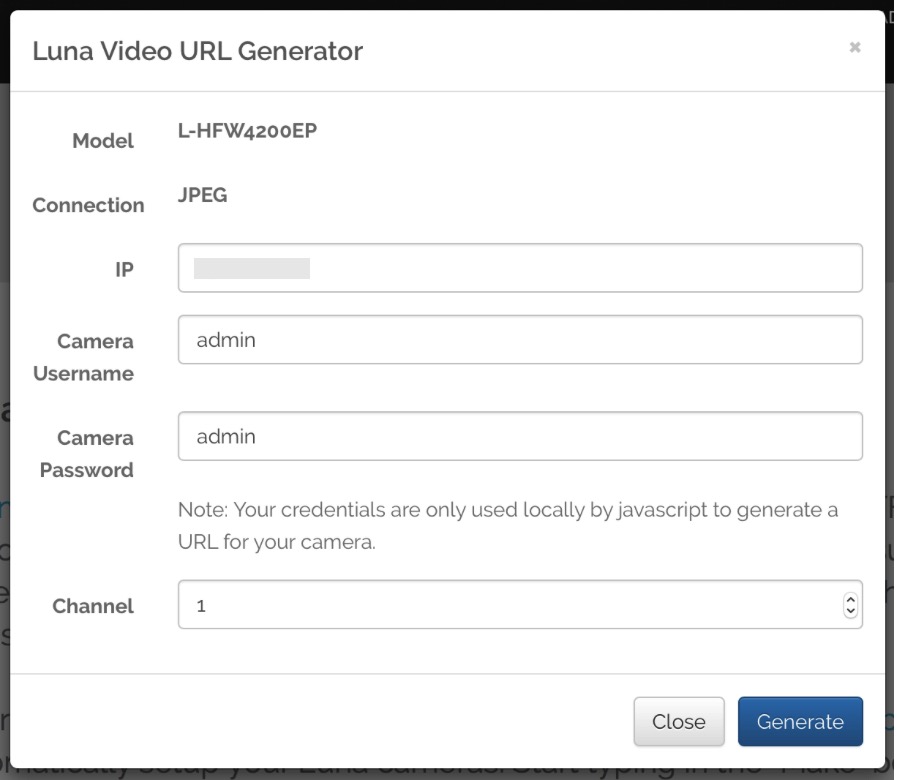
Não divulgue a terceiros os dados necessários para obter a ligação RTSP ou a própria ligação de fluxo de vídeo.
Recomenda-se a especificação de dados incorretos ao gerar uma ligação RTSP e a sua alteração para os dados corretos após a conclusão da geração. Assim, estará protegido contra a interceção de ligações de fluxo por serviços de terceiros ou keyloggers.
3. Clique em Gerar. Obterá uma ligação para o seu fluxo de vídeo. Se necessário, substitua os dados incorretos no link pelos corretos.

Pode verificar o funcionamento da ligação RTSP utilizando o leitor multimédia VLC ou qualquer outro leitor que permita ver vídeo em fluxo contínuo.
Como visualizar um vídeo de uma câmara IP utilizando o leitor multimédia VLC
- Abra o leitor multimédia VLC.
- Clique em Ficheiro — Abrir rede.
- Insira o link RTSP e clique Abrir.
Se o vídeo não estiver a ser transmitido, existe um problema nas definições da câmara ou do equipamento de rede. Verifique todas as definições.
Se o equipamento estiver corretamente configurado, mas o fluxo da câmara de vídeo não for apresentado, contacte o serviço de assistência técnica do fabricante do sistema de videovigilância.
Guarde a ligação para o fluxo de vídeo que obteve. Precisará dele para adicionar a câmara IP à app Ajax.
Como adicionar uma câmara IP à app Ajax
- Aceda o separador Dispositivos
.
- Pressione:
- Se utiliza iOS: Adicionar dispositivo — Adicione câmara
- Se utiliza o Android: Adicione câmara
- Selecione a opção câmara RTSP.
- Especifique:
- nome da câmara
- link para o fluxo de vídeo
- o sala ao qual o dispositivo de videovigilância está conectado
- Press Add. O fluxo de vídeo será adicionado à app Ajax e estará disponível para visualização.
As capacidades da app Ajax durante a visualização de fluxos de vídeo
Ao visualizar fluxos de vídeo na app Ajax, a qualidade do vídeo não se deteriora. A qualidade do vídeo depende da câmara e das suas definições.
Para determinadas câmaras, é possível especificar a qualidade de vídeo na ligação RTSP.
Para ver um vídeo, clique no ícone de transmissão na app Ajax.
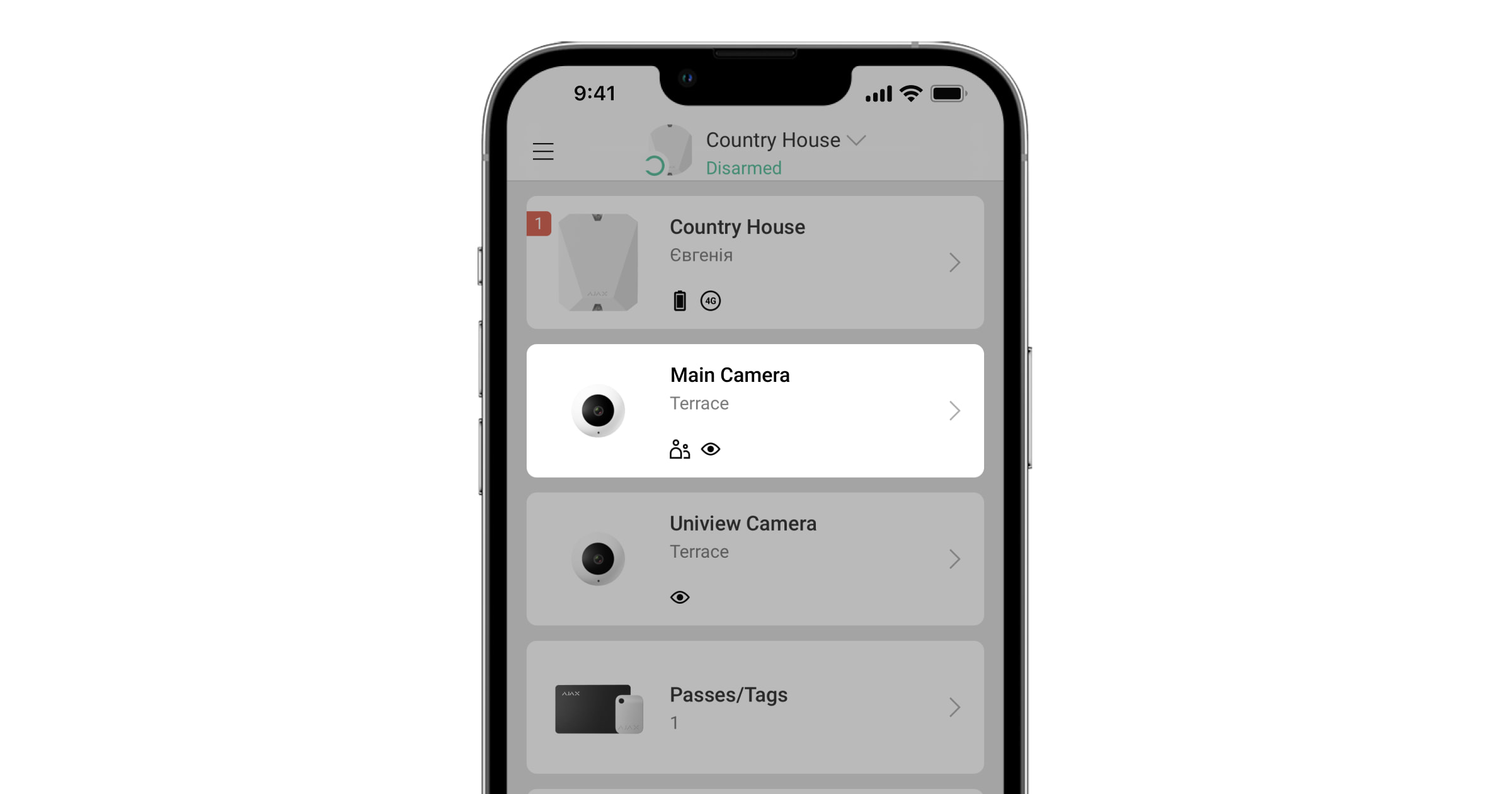
Para expandir o fluxo para ecrã inteiro, altere a orientação do smartphone para paisagem. Entretanto, a função de rotação automática deve ser ativada nas definições do smartphone.
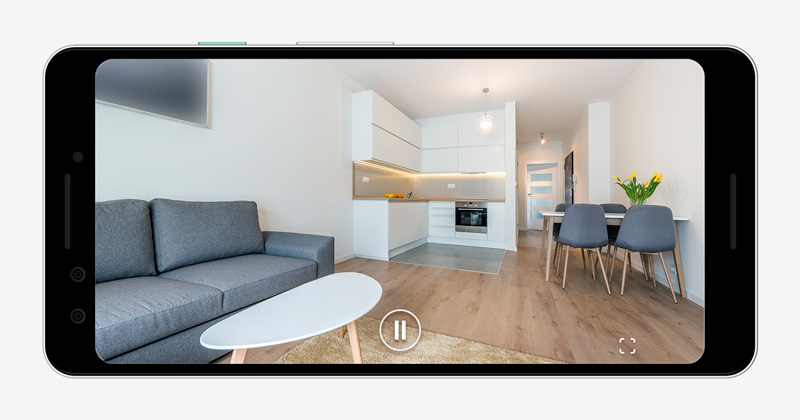
Para fazer pausa num vídeo, clique no botão de pausa.
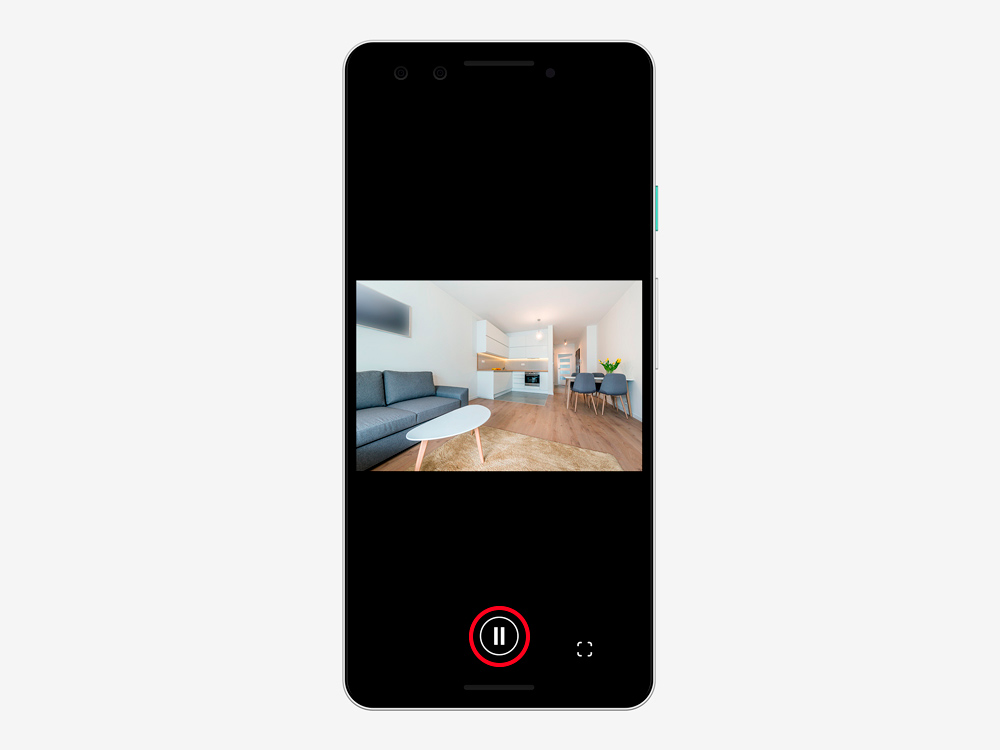
Para tirar uma fotografia, clique no botão indicado na imagem do ecrã. A captura de ecrã é guardada na memória do smartphone.
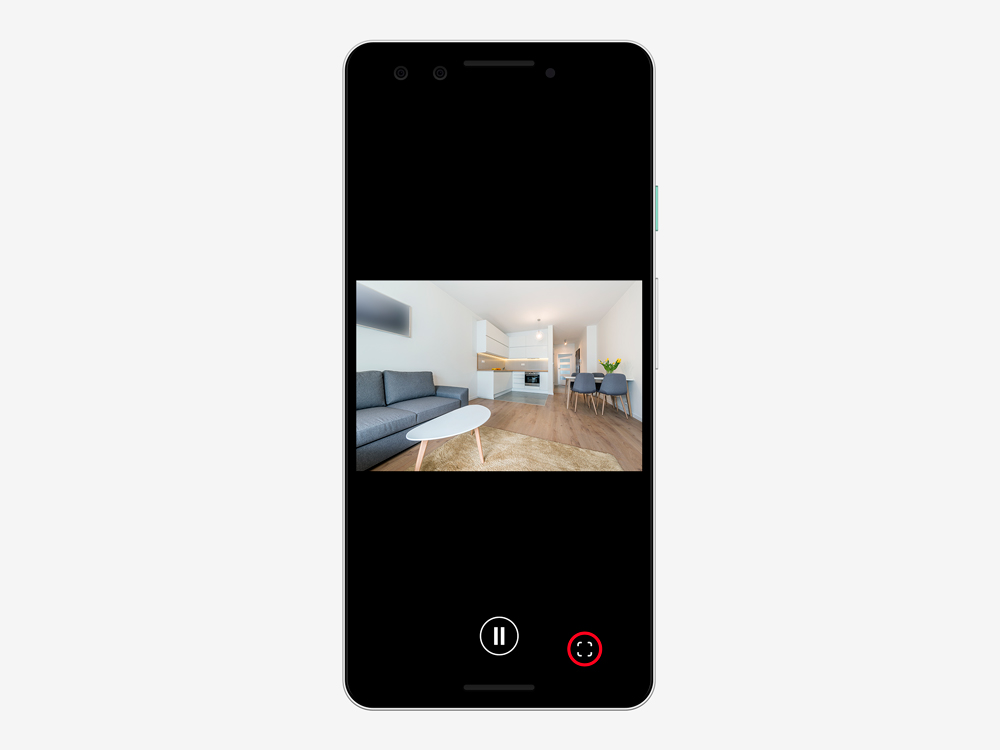
A imagem da câmara também pode ser redimensionada com um gesto de pinça.
As câmaras IP ligadas funcionam de forma independente do hub. Se o hub perder a ligação com o serviço Ajax Cloud mas as câmaras ou o gravador de vídeo continuarem a funcionar, os fluxos de vídeo estarão disponíveis para visualização na app Ajax.
Nas definições da câmara , pode alterar o seu nome, a ligação RTSP, redefinir a sala de localização e eliminar a câmara.
Como configurar o acesso do utilizador aos fluxos e arquivos da câmara
As apps Ajax permitem-lhe configurar os utilizadores que podem aceder ao fluxo de vídeo e ao arquivo. As definições de privacidade podem ser geridas por:
- Utilizador do sistema com direitos de administrador (por defeito).
- Utilizador do sistema sem direitos de administrador, se lhe tiver sido concedido esse direito.
Os utilizadores das apps PRO não podem gerir as definições de privacidade, mas podem determinar o tipo de acesso para outros utilizadores.
Para configurar o acesso dos utilizadores às câmaras:
- Inicie sessão no Ajax Security System ou na app Ajax Desktop.
- Selecionar um espaço.
- Toque no ícone da engrenagem
para aceder às definições do espaço.
Na app Ajax Security System, aceda primeiro ao separador Controlo
e, em seguida, abra as definições de espaço.
- Aceda às definições de Privacidade.
- Selecione a categoria de utilizador: Utilizadores, Instaladores e Empresas.
- Selecione o utilizador do sistema.
- Selecione a câmara.
- Ative ou desative a opção Ver transmissão em direto da câmara.
- Configure outros direitos de acesso se a opção Ver transmissão em direto da câmara estiver ativada:
- Visualizar arquivo da câmara.
- Descarregar vídeo do arquivo (disponível após ativar o interruptor Visualizar arquivo da câmara).
- Assista com som.
- Utilize o recurso de pan-tilt-zoom (PTZ).
- Especifique quando o utilizador pode ter acesso às possibilidades da câmara: a qualquer momento ou quando o dispositivo está no modo armado.
Também está disponível para conceder acesso temporário aos dispositivos de videovigilância apenas após um alarme para os funcionários da empresa.
- Toque em Voltar / clique em Guardar para aplicar as alterações.
- Repita os passos 4–11 para outras câmaras e utilizadores.
